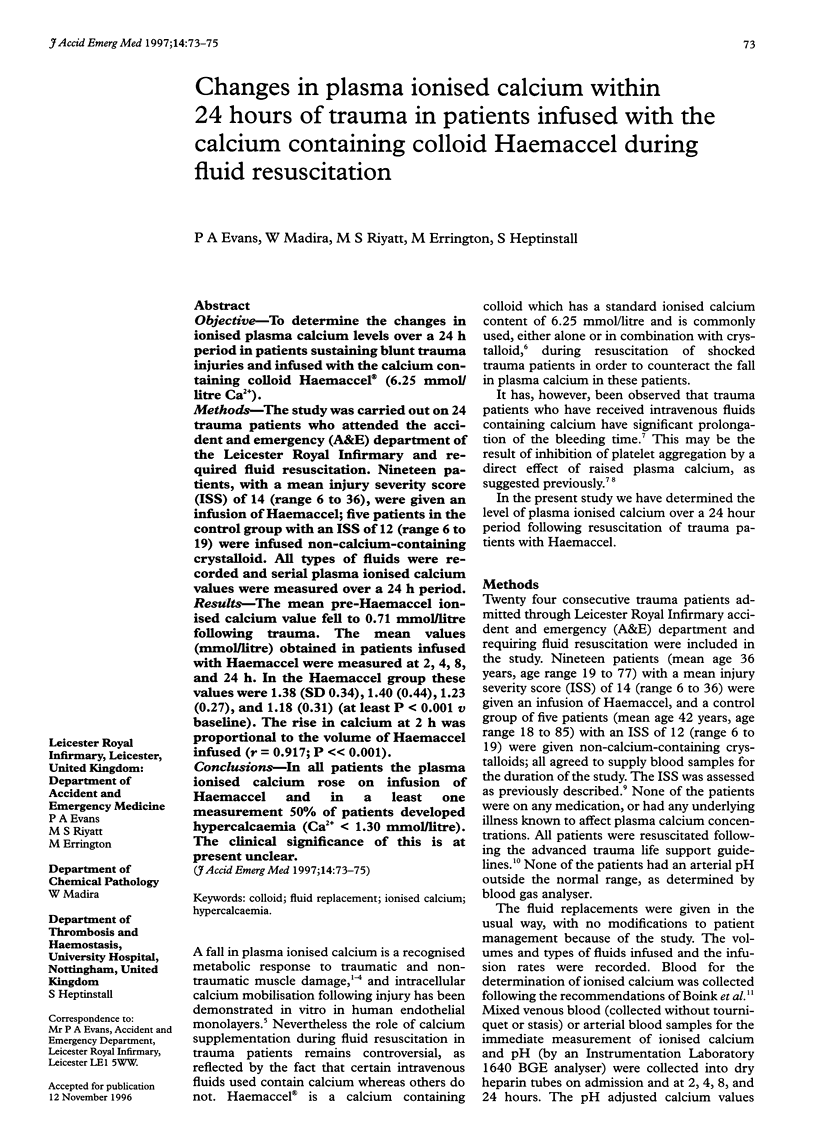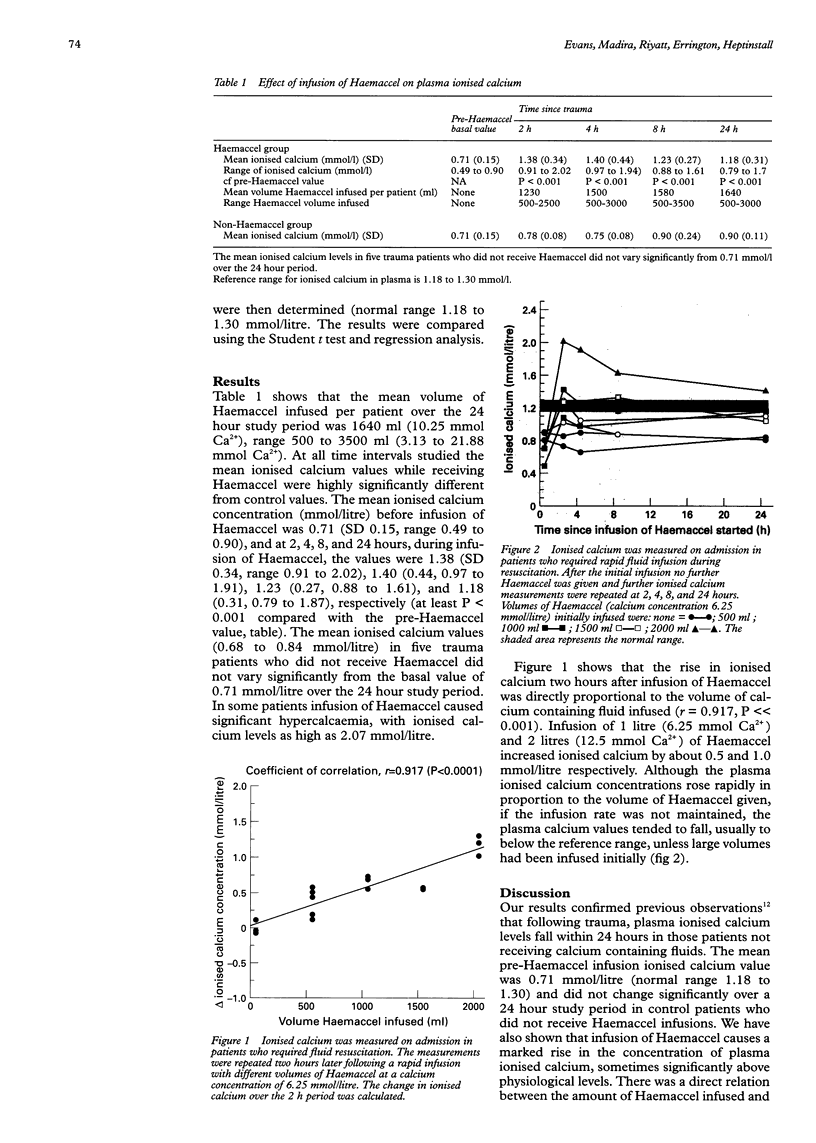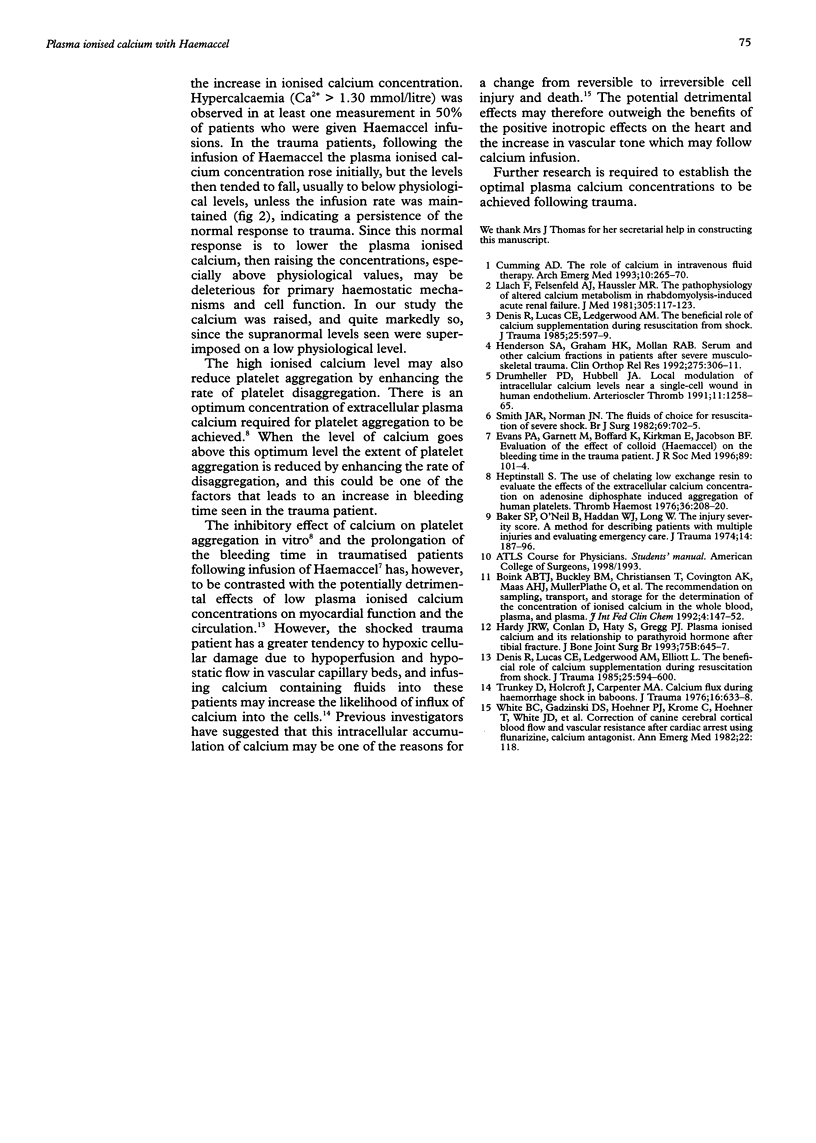Abstract
OBJECTIVE: To determine the changes in ionised plasma calcium levels over a 24 h period in patients sustaining blunt trauma injuries and infused with the calcium containing colloid Haemaccel (6.25 mmol/ litre Ca2+). METHODS: The study was carried out on 24 trauma patients who attended the accident and emergency (A&E) department of the Leicester Royal Infirmary and required fluid resuscitation. Nineteen patients, with a mean injury severity score (ISS) of 14 (range 6 to 36), were given an infusion of Haemaccel; five patients in the control group with an ISS of 12 (range 6 to 19) were infused non-calcium-containing crystalloid. All types of fluids were recorded and serial plasma ionised calcium values were measured over a 24 h period. RESULTS: The mean pre-Haemaccel ionised calcium value fell to 0.71 mmol/litre following trauma. The mean values (mmol/litre) obtained in patients infused with Haemaccel were measured at 2, 4, 8, and 24 h. In the Haemaccel group these values were 1.38 (SD 0.34), 1.40 (0.44), 1.23 (0.27), and 1.18 (0.31) (at least P < 0.001 v baseline). The rise in calcium at 2 h was proportional to the volume of Haemaccel infused (r = 0.917; P < < 0.001). CONCLUSIONS: In all patients the plasma ionised calcium rose on infusion of Haemaccel and in a least one measurement 50% of patients developed hypercalcaemia (Ca2+ < 1.30 mmol/litre). The clinical significance of this is at present unclear.
Full text
PDF


Selected References
These references are in PubMed. This may not be the complete list of references from this article.
- Baker S. P., O'Neill B., Haddon W., Jr, Long W. B. The injury severity score: a method for describing patients with multiple injuries and evaluating emergency care. J Trauma. 1974 Mar;14(3):187–196. [PubMed] [Google Scholar]
- Boink A. B., Buckley B. M., Christiansen T. F., Covington A. K., Maas A. H., Müller-Plathe O., Sachs C., Siggaard-Andersen O. Recommendation on sampling, transport, and storage for the determination of the concentration of ionized calcium in whole blood, plasma, and serum. IFC Scientific Division, Working Group on Ion-Selective Electrodes (WGSE). J Int Fed Clin Chem. 1992 Sep;4(4):147–152. [PubMed] [Google Scholar]
- Cumming A. D. The role of calcium in intravenous fluid therapy. Arch Emerg Med. 1993 Dec;10(4):265–270. doi: 10.1136/emj.10.4.265. [DOI] [PMC free article] [PubMed] [Google Scholar]
- Denis R., Lucas C. E., Ledgerwood A. M., Wallace J. R., Grabow D. E., Harrigan C., Dawe E. J. The beneficial role of calcium supplementation during resuscitation from shock. J Trauma. 1985 Jul;25(7):594–600. doi: 10.1097/00005373-198507000-00004. [DOI] [PubMed] [Google Scholar]
- Drumheller P. D., Hubbell J. A. Local modulation of intracellular calcium levels near a single-cell wound in human endothelial monolayers. Arterioscler Thromb. 1991 Sep-Oct;11(5):1258–1265. doi: 10.1161/01.atv.11.5.1258. [DOI] [PubMed] [Google Scholar]
- Hardy J. R., Conlan D., Hay S., Gregg P. J. Serum ionised calcium and its relationship to parathyroid hormone after tibial fracture. J Bone Joint Surg Br. 1993 Jul;75(4):645–649. doi: 10.1302/0301-620X.75B4.8331124. [DOI] [PubMed] [Google Scholar]
- Henderson S. A., Graham H. K., Mollan R. A. Serum and other calcium fractions in patients after severe musculoskeletal trauma. Clin Orthop Relat Res. 1992 Feb;(275):306–311. [PubMed] [Google Scholar]
- Heptinstall S. The use of a chelating ion-exchange resin to evaluate the effects of the extracellular calcium concentration on adenosine diphosphate induced aggregation of human blood platelets. Thromb Haemost. 1976 Aug 31;36(1):208–220. [PubMed] [Google Scholar]
- Llach F., Felsenfeld A. J., Haussler M. R. The pathophysiology of altered calcium metabolism in rhabdomyolysis-induced acute renal failure. Interactions of parathyroid hormone, 25-hydroxycholecalciferol, and 1,25-dihydroxycholecalciferol. N Engl J Med. 1981 Jul 16;305(3):117–123. doi: 10.1056/NEJM198107163050301. [DOI] [PubMed] [Google Scholar]
- Smith J. A., Norman J. N. The fluid of choice for resuscitation of severe shock. Br J Surg. 1982 Dec;69(12):702–705. doi: 10.1002/bjs.1800691205. [DOI] [PubMed] [Google Scholar]
- Trunkey D., Holcroft J., Carpenter M. A. Calcium flux during hemorrhagic shock in baboons. J Trauma. 1976 Aug;16(08):633–638. doi: 10.1097/00005373-197608000-00007. [DOI] [PubMed] [Google Scholar]


